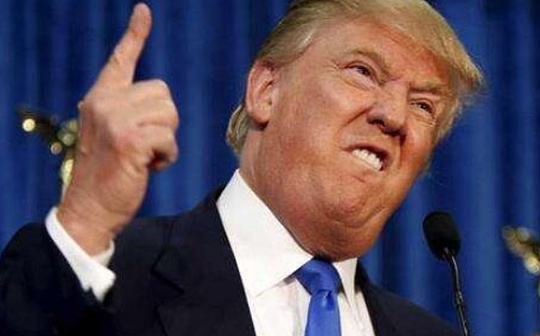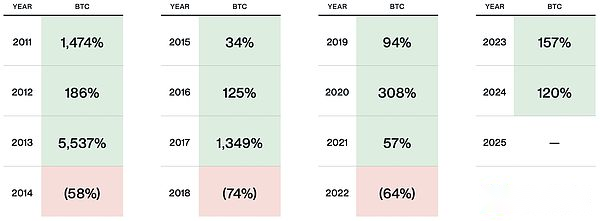
Author: Matt Hougan, Chief Investment Officer, Bitwise; Compiled by: 0xjs@Bitlink Vision
I have spent most of my time thinking about the four-year cycle of Bitcoin.
Specifically, I have been wondering whether Washington’s recent change in attitude towards cryptocurrencies is enough to become a major catalyst to “break” the four-year cycle and continue the current bull market for cryptocurrencies to 2026 and beyond.
This is a question I’ve been asked frequently recently.Let’s discuss it in depth below.
What is a four-year cycle?

Historically, Bitcoin fluctuated in four years in a cycle, first with a sharp rise in three years, and then a pullback.
Source: Bitwise Asset Management Company.The data range is from December 31, 2010 to December 31, 2024.
Performance information is for reference only.The earnings reflect the returns of Bitcoin itself, not the returns of any fund or account, and do not include any fees.Past performance cannot predict the future performance of any investment strategy.The cycle length of future cryptocurrencies may not be four years; the four-year increments here are based on historical data for illustration purposes, not predictions of future results.This material represents an assessment of the market environment at a specific time and is not a prediction of future events or a guarantee of future results.
Readers who follow this memo know that I have been talking about the four-year cycle since mid-2022, when Bitcoin was in a deep downturn, and my point is “waiting.”
Sure enough, Bitcoin performed well in 2023 and 2024.According to this model, 2025 should also perform well, which is what I expected.But investors will naturally start to think about whether the market will be reset in 2026.
What causes the four-year cycle?
The four-year cycle of cryptocurrencies is the same force that drives wider growth and recession cycles in the macro economy.
This cycle begins with a catalyst—a technological breakthrough or event that stimulates investor interest and brings new capital to the market.For example, in 2011, the first companies that allowed individuals to buy Bitcoin (such as Coinbase, Mt. Gox, etc.) were established, and retail investors used this to bring new funds into the cryptocurrency space.Until then, only computer scientists knew how to buy Bitcoin.As expected, the price of Bitcoin rose with it.
Once a bull market starts, it will form its own development momentum.The price increase attracted attention and more funds poured in.As the bull market accelerates, investors become greedy and leverage begins to accumulate.Sometimes fraud occurs.In other cases, traditional infrastructure can be overwhelmed by excessive demand.In either case, problems will eventually arise.In 2014, Mt. Gox, the largest custodial institution, went bankrupt; in 2018, the US SEC cracked down on the initial token issuance (ICO).
The callback is painful, and deleveraging brings despair.But then, a new breakthrough will inevitably appear and restart this cycle.
I emphasize again: this cycle is not unique to cryptocurrencies.Some have tried to link it to Bitcoin’s “halving” every four years, but these halving events do not match the cycle, with halving happening in 2016, 2020 and 2024, respectively.
This is the ancient economic cycle, but it is magnified under the high volatility of cryptocurrencies.
Current cycle
The current cycle stems from the massive deleveraging that occurred after a series of major scandals and bankruptcies in 2022 (such as FTX, Sanjiang Capital, Genesis, BlockFi, Celsius, etc.).
At Bitwise, we call this cycle the “mainstream cycle” and we believe its distinctive feature is the entry of mainstream investors into the cryptocurrency space.
The catalyst to start the current cycle came on March 10, 2023, when Grayscale won a big first round of debate in its legal lawsuit against the U.S. Securities and Exchange Commission on Bitcoin Exchange Trading Funds (ETFs)Win a lot.Grayscale sued the SEC for “arbitrary and capricious” behavior when rejecting the spot Bitcoin ETF application and requested the court to order the SEC to reconsider it.
Grayscale’s victory was very thorough.Although the verdict was only issued months later, the launch of Bitcoin ETFs has become obvious since then, and this will bring cryptocurrencies to the masses.Sure enough, the Bitcoin ETF was launched in January 2024 and set a record of capital inflows.
When Grayscale filed the lawsuit, the price of Bitcoin was $22,218.Today it costs $102,674.The mainstream era has arrived.
Washington’s attitude change and the possibility of breaking the four-year cycle
If the classic four-year cycle is followed, 2025 will be a great year for cryptocurrencies.I also think this will be: We publicly predict that Bitcoin price will double this year to exceed $200,000, driven by ETF capital inflows and corporate and government purchases of Bitcoin.This prediction may be relatively conservative.
Having said that, I still see early signs of overheating in the system.Nowadays, a large number of companies are raising funds and debts to buy Bitcoin, the “bitcoin lending projects” have increased significantly, allowing large holders of Bitcoin to take advantage of their wealth without selling Bitcoin assets.These actions are not at fault in themselves, but they are in the form of leverage and are just the tip of the iceberg.The growth of derivative contracts, leveraged ETFs and other tools all show me that the market is starting to really heat up.
All of these situations have led me to think the four-year cycle is still continuing.
But then President Trump issued an executive order.
Last week, President Trump issued an executive order that was extremely good for the cryptocurrency sector, which made me start to rethink.The executive order lists the development of the U.S. digital asset ecosystem as a “national priority.”It points the direction for a clear regulatory framework for cryptocurrencies and considers establishing a “national cryptocurrency reserve”.Coupled with the actions taken by the SEC, which now supports cryptocurrency, has opened the way for major Wall Street banks and investors to enter the field in a big way.
In my opinion, the launch of ETFs is a major event, bringing hundreds of billions of dollars in funding to the cryptocurrency ecosystem from new investors, which is also driving the current cycle.But the full mainstreaming of cryptocurrencies—the kind envisioned by Trump’s executive order, that banks custodialize cryptocurrencies with other assets, stablecoins are widely integrated into the global payment ecosystem, and large institutions establish positions in the cryptocurrency field—I firmly believe this will bring trillions of dollars in funding.
My view on the future
The question I am thinking about is that the positive impact of this executive order and other changes in Washington will be revealed in years rather than months.Ideally, it takes one year to develop and implement a new cryptocurrency regulatory framework.Wall Street giants need to fully adapt to the possibilities brought by cryptocurrencies, which will take longer.
If we don’t feel these effects until next year, will we really usher in a new “crypto winter” in 2026?Even if investors know that we have entered a new world of popularization of cryptocurrencies, will they still enter a dormant state?If BlackRock CEO Larry Fink is calling for Bitcoin to rise to $700,000, will we really see a 70% pullback?
I guess we are not completely out of the four-year cycle.As the bull market advances, leverage will continue to accumulate, the market will overheat, and bad actors will also appear.At some point, when the market is overspread, a sharp pullback may occur.
But I guess any callback will be shorter and shallower than in the past.Why?The cryptocurrency space is mature, with more buyers than ever before, and more value-oriented investors.I expect volatility, but I’m not sure I’ll be bearish on cryptocurrencies in 2026.
For now, everything is moving forward at full speed.The cryptocurrency train has set off.








